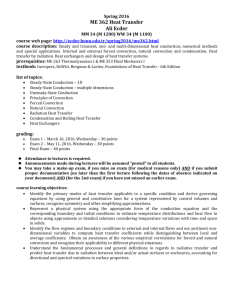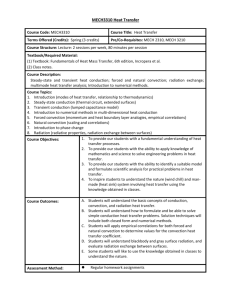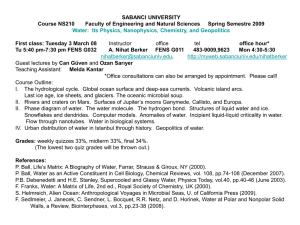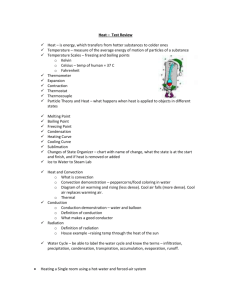syllabus
advertisement
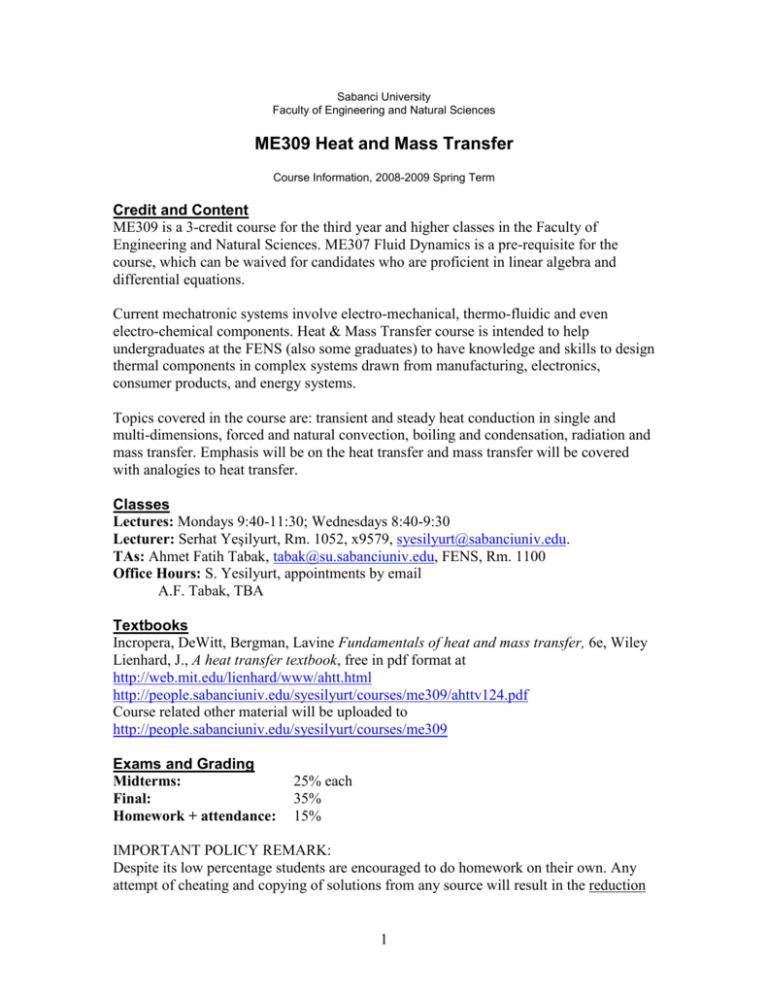
Sabanci University Faculty of Engineering and Natural Sciences ME309 Heat and Mass Transfer Course Information, 2008-2009 Spring Term Credit and Content ME309 is a 3-credit course for the third year and higher classes in the Faculty of Engineering and Natural Sciences. ME307 Fluid Dynamics is a pre-requisite for the course, which can be waived for candidates who are proficient in linear algebra and differential equations. Current mechatronic systems involve electro-mechanical, thermo-fluidic and even electro-chemical components. Heat & Mass Transfer course is intended to help undergraduates at the FENS (also some graduates) to have knowledge and skills to design thermal components in complex systems drawn from manufacturing, electronics, consumer products, and energy systems. Topics covered in the course are: transient and steady heat conduction in single and multi-dimensions, forced and natural convection, boiling and condensation, radiation and mass transfer. Emphasis will be on the heat transfer and mass transfer will be covered with analogies to heat transfer. Classes Lectures: Mondays 9:40-11:30; Wednesdays 8:40-9:30 Lecturer: Serhat Yeşilyurt, Rm. 1052, x9579, syesilyurt@sabanciuniv.edu. TAs: Ahmet Fatih Tabak, tabak@su.sabanciuniv.edu, FENS, Rm. 1100 Office Hours: S. Yesilyurt, appointments by email A.F. Tabak, TBA Textbooks Incropera, DeWitt, Bergman, Lavine Fundamentals of heat and mass transfer, 6e, Wiley Lienhard, J., A heat transfer textbook, free in pdf format at http://web.mit.edu/lienhard/www/ahtt.html http://people.sabanciuniv.edu/syesilyurt/courses/me309/ahttv124.pdf Course related other material will be uploaded to http://people.sabanciuniv.edu/syesilyurt/courses/me309 Exams and Grading Midterms: Final: Homework + attendance: 25% each 35% 15% IMPORTANT POLICY REMARK: Despite its low percentage students are encouraged to do homework on their own. Any attempt of cheating and copying of solutions from any source will result in the reduction 1 of homework grade to zero or disciplinary action. If cheating in homework becomes systematic throughout the class, homework’s contribution will be removed from the calculation of the final grades. Lectures (Tentative schedule) Wk 1. Introduction. Origins of rate equations, Conservation of energy, Surface Energy Balance (Ch. 1) Wk 2. Introduction to conduction: Conduction rate equations, thermal properties of matter (2.1-2.3). Heat diffusion equation, boundary and initial conditions (2.42.5) Wk 3. One dimensional steady-state conduction (3.1-2). Radial systems, cylinder and sphere, heat generation (3.3-5) Wk 4. Fins (3.6). 2D steady-state conduction (4.2,4.4-5) Wk 5. Lumped capacitance method (5.1-3). Wall convection, semi-infinite solid (5.4-8) Wk 6. MIDTERM I. Introduction to convection (6.1). Wk 7. Convection boundary layers (6.2-10). Flow over plates (7.1-3). Flow over cylinders, spheres; Impinging jets; Packed beds (7.4-9) Wk 8. Internal flows, energy balance (8.1-3). Laminar flow in circular tubes, convection correlations (8.4-10) Wk 9. Free convection, external correlations (9.1-6). Parallel plate channels, enclosures (9.7-11) Wk 10. Boiling modes, correlations (10.1-4). Two-phase flow, dropwise and film condensation (10.5-12) Wk 11. SEMESTER BREAK Wk 12. Heat exchangers, overall heat transfer coefficient (Ch. 11). Blackbody Radiation, surface emission, absorption, reflection, transmission (12.1-5) Wk 13. Gray surfaces, view factors (12.6-9, 13.1). Radiation exchange between surfaces (13.2-6) Wk 14. Wk 15. MIDTERM II. Diffusion mass transfer, Fick’s Law (14.1). Conservation of species, boundary conditions, Maxwell-Stefan equations (14.23). Mass diffusion with chemical reactions at the surface (14.4). Diffusion with reactions in the bulk (14.5-7) IMPORTANT NOTICE: Lectures will be on fundamental concepts and methods. Problem solving will be limited to basic examples in lectures. Students must attend recitations regularly for problem solving sessions. Those who need additional problem solution sessions may ask for additional recitation hours and seek for additional tutoring from the instructor and TA on office hours. 2
![Applied Heat Transfer [Opens in New Window]](http://s3.studylib.net/store/data/008526779_1-b12564ed87263f3384d65f395321d919-300x300.png)
